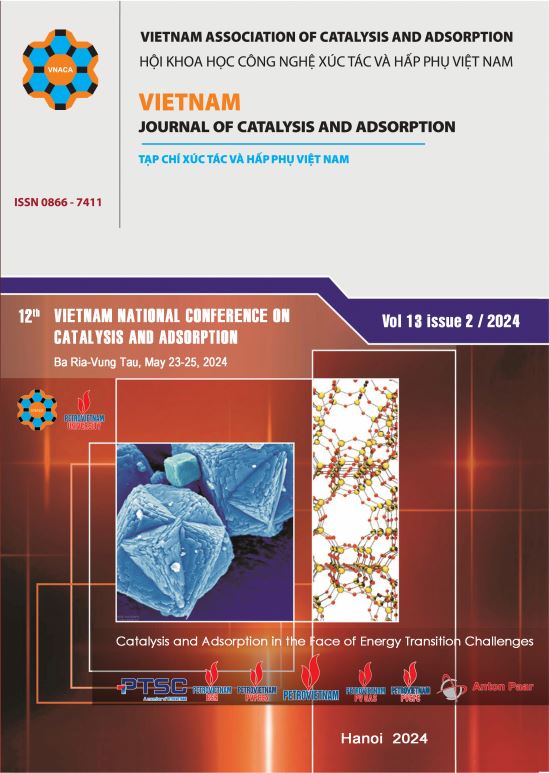Synthesis, characterization, and photocatalytic properties of reed biochar/TiO2 composites
DOI:
https://doi.org/10.62239/jca.2024.032Keywords:
Titania, biochar, photodegradation, TiO2/biochar, doxycyclineAbstract
In this study, TiO2/biochar (TBC) materials were successfully synthesized by simple hydrolysis. The photocatalytic activity of the products was evaluated through the photodegradation ability of doxycycline (DC) in aqueous solution. Characterization shows that TiO2 nanoparticles are well dispersed on the biochar surface. The presence of biochar helped improve the specific surface area, narrow the band gap and enhance the optical absorption in the visible light region of TiO2. The TBC composite at TiO2/biochar mass ratio = 1/0.25 showed the highest photodegradation efficiency, about 3.77 times higher than pure TiO2. Kinetic studies showed that DC degradation followed an apparent first-order kinetic model with rate constant kapp = 2.66×10-2 min-1 at DC concentration of 7.0 mg/L. Research shows that TiO2/biochar material has great potential for treating antibiotic-contaminated wastewater.
Downloads
References
X. Feng, X. Li, B. Su, J. Ma, Diamond and Related Materials 131 (2023). https://doi.org/10.1016/j.diamond.2022.109560
J.R. Kim, E. Kan, J Environ Manage 180 (2016) 94. https://doi.org/10.1016/j.jenvman.2016.05.016
J. Bolobajev, M. Trapido, A. Goi, Chemosphere 153 (2016) 220. https://doi.org/10.1016/j.chemosphere.2016.03.042
A. Mohammadi, S. Pourmoslemi, Water Science & Technology 2017 (2018) 791. 10.2166/wst.2018.237
Y. He, Y. Wang, J. Hu, K. Wang, Y. Zhai, Y. Chen, Y. Duan, Y. Wang, W. Zhang, Journal of Materials Research and Technology 11 (2021) 1308. https://doi.org/10.1016/j.jmrt.2021.01.077
M. Shahrezaei, S. Habibzadeh, A.A. Babaluo, H. Hosseinkhani, M. Haghighi, A. Hasanzadeh, R. Tahmasebpour, Journal of Experimental Nanoscience 12 (2016) 45. https://doi.org/10.1080/17458080.2016.1258495
J. Yu, Q. Xiang, M. Zhou, Applied Catalysis B: Environmental 90 (2009) 595. https://doi.org/10.1016/j.apcatb.2009.04.021
M. Jafari, M.R. Rahimi, M. Ghaedi, H. Javadian, A. Asfaram, J Colloid Interface Sci 507 (2017) 172. https://doi.org/10.1016/j.jcis.2017.07.056
T. Fazal, A. Razzaq, F. Javed, A. Hafeez, N. Rashid, U.S. Amjad, M.S. Ur Rehman, A. Faisal, F. Rehman, J Hazard Mater 390 (2020) 121623. https://doi.org/10.1016/j.jhazmat.2019.121623
O. Bechambi, S. Sayadi, W. Najjar, Journal of Industrial and Engineering Chemistry 32 (2015) 201. https://doi.org/10.1016/j.jiec.2015.08.017
Z. Pan, L. Qian, J. Shen, J. Huang, Y. Guo, Z. Zhang, Chemical Engineering Journal 426 (2021) 130385. https://doi.org/10.1016/j.cej.2021.130385
D. Liang, Y. Huang, F. Wu, J. Luo, X. Yi, J. Wang, X. Qiu, Applied Surface Science 487 (2019) 322. https://doi.org/10.1016/j.apsusc.2019.05.088
W. Liu, J. Zhou, Z. Hu, Separation and Purification Technology 227 (2019) 115665. https://doi.org/10.1016/j.seppur.2019.06.003
M. Lin, F. Li, W. Cheng, X. Rong, W. Wang, Chemosphere 288 (2022) 132620. https://doi.org/10.1016/j.chemosphere.2021.132620
L. Meng, W. Yin, S. Wang, X. Wu, J. Hou, W. Yin, K. Feng, Y.S. Ok, X. Wang, Chemosphere 239 (2020) 124713. https://doi.org/10.1016/j.chemosphere.2019.124713
Downloads
Published
Issue
Section
How to Cite
Share
Funding data
-
Bộ Giáo dục và Ðào tạo
Grant numbers B2022.SPD.562.07










